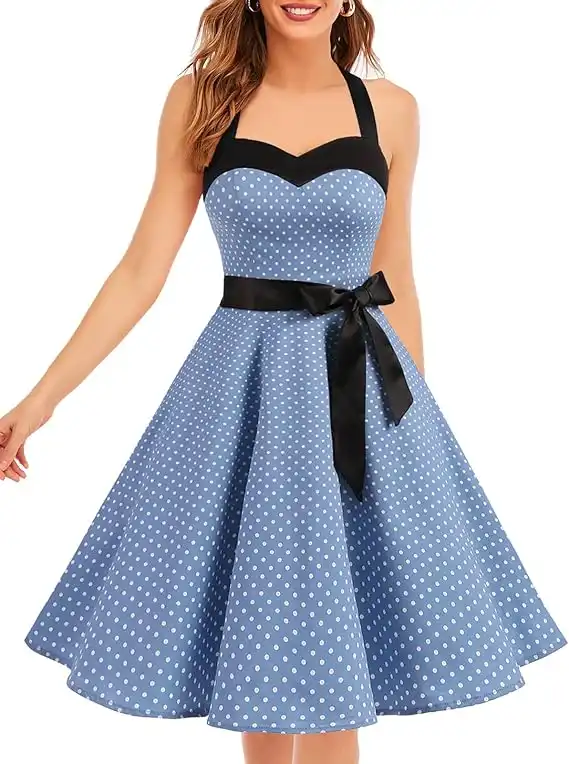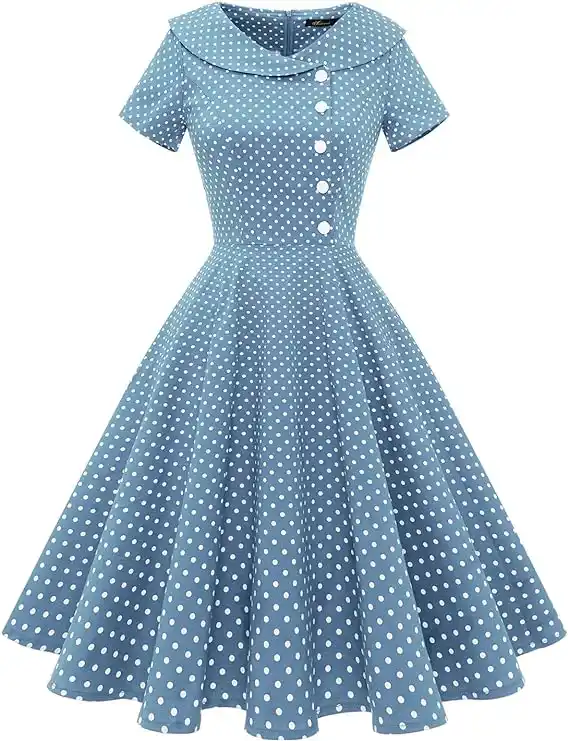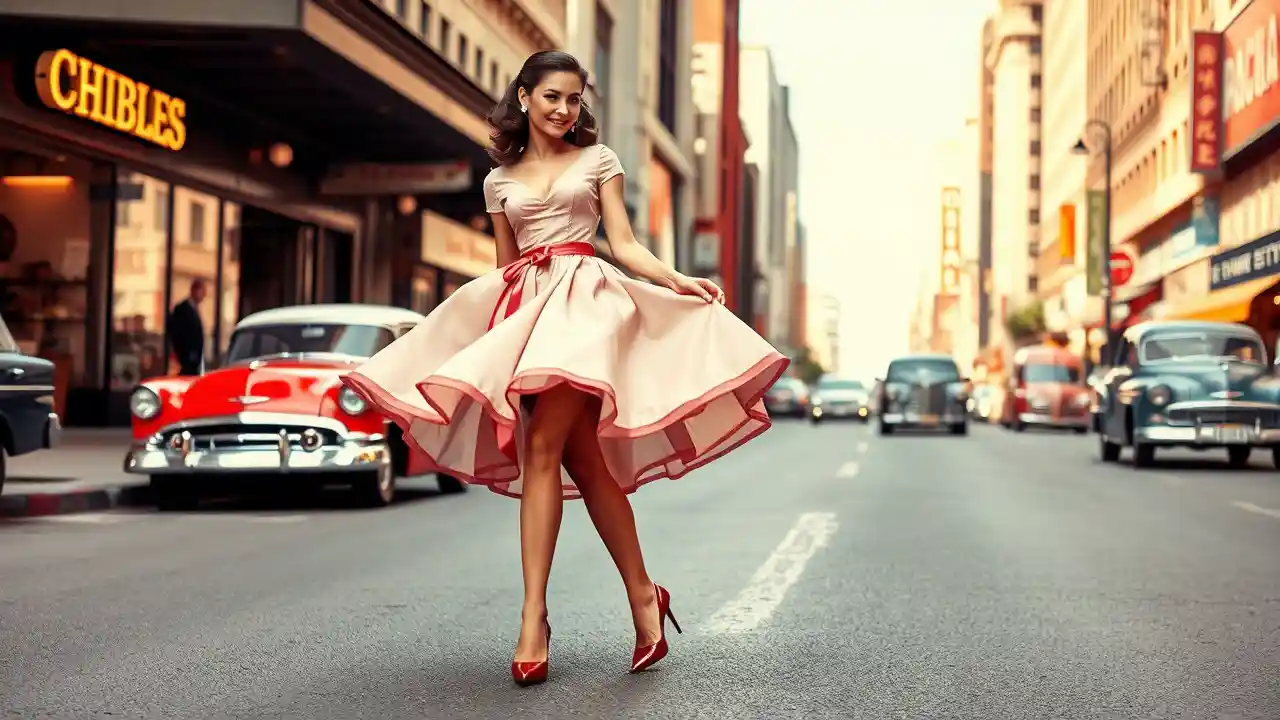The swish of a full skirt, the clickety-clack of heels on pavement, the rustle of crisp petticoats – few eras in fashion history capture the imagination quite like the 1950s.
In the aftermath of World War II’s austerity, fashion exploded into an celebration of femininity and luxury that would define an entire decade.
The 1950s weren’t just about clothes; they were about a complete transformation in how women presented themselves to the world.
What makes 1950s fashion dresses so captivating, even seven decades later? Perhaps it’s their almost magical ability to make every woman feel like a silver screen starlet, or maybe it’s the undeniable craftsmanship that went into each garment.
From the local housewife to Hollywood royalty, 1950s fashion dresses represented an unprecedented democratization of style and glamour.
Contents
The Revolution of Silhouettes: Defining the 1950s Look
If the 1940s were shaped by wartime practicality, the 1950s were all about excess and expression. Christian Dior’s “New Look” of 1947 set the stage for what would become the decade’s defining silhouette: a tiny, nipped-in waist exploding into yards of fabric below. But that wasn’t the only story being told through fashion.
The Full Skirt: Queen of the Dance Floor
Nothing says “1950s” quite like the full-skirted swing dress. These dresses weren’t just garments; they were engineering marvels, often requiring up to 15 yards of fabric and multiple petticoats to achieve their characteristic shape.

Watch any vintage footage of a 1950s dance floor, and you’ll see these dresses in their natural habitat – twirling, spinning, and creating magical moments of motion and joy.
The construction of a proper swing dress was an art form in itself. Layers of netting and tulle created the foundational structure, while the outer fabric – whether cotton, silk, or synthetic – would float ethereally above.
Women would often wear multiple petticoats, sometimes up to seven at once, to achieve the desired fullness. In summer heat, it was a testament to dedication to style.
The Pencil Dress: Sophistication in Motion
While full skirts dominated casual wear, the pencil dress offered a sleeker, more sophisticated alternative. These form-fitting garments hugged curves and ended just below the knee, requiring a special kind of grace to navigate stairs and sidewalks.
The “wiggle dress,” as it was sometimes called, demanded attention not through volume but through careful tailoring and strategic seaming.
Marilyn Monroe‘s iconic white dress from “The Seven Year Itch” might be the most famous full-skirted moment in cinema, but it was the pencil dress that truly showcased the era’s masterful tailoring.
These dresses required precise dart placement and often featured kick pleats at the back hem – a small concession to mobility that didn’t compromise the sleek silhouette.
The Shirtwaist: Practical Meets Pretty
Not every 1950s dress was designed for glamour. The shirtwaist dress – with its buttoned bodice and full or straight skirt – became the uniform of the American housewife. But don’t let its practical origins fool you; these dresses were often executed in beautiful prints and featured thoughtful details like contrast piping, decorative buttons, and clever pocket placement.
Fabrics and Patterns: The Canvas of 1950s Style
The 1950s witnessed an explosion in textile innovation. New synthetic fabrics like nylon and polyester joined traditional materials like cotton, wool, and silk. Each fabric choice carried its own social significance and practical application.
The Material World
Cotton remained queen for everyday wear, but it wasn’t your grandmother’s cotton. New finishing processes created fabrics that were crisp, wrinkle-resistant, and easy to care for. Polished cotton became a favorite for special occasion dresses, offering the perfect balance of structure and lightness.
Silk taffeta rustled its way through every major social event, while chiffon floated through evening affairs with ethereal grace. The decade’s love affair with synthetic fabrics meant that previously luxury-only looks could be achieved at more accessible price points. Nylon could mimic silk, while new polyester blends promised easy care without sacrificing style.
Pattern Play
If solid colors were the canvas, patterns were the artistic expression of the era. Polka dots ranged from tiny pin dots to bold statements, while florals ran the gamut from delicate scattered blossoms to oversized tropical prints. Novelty prints told stories across skirts – poodles, telephones, and even kitchen implements made their way onto fabric.
Plaid enjoyed particular popularity, especially in shirtwaist dresses. Gingham checks became synonymous with summer picnics and casual wear. These patterns weren’t just decorative; they were conversations starters, mood lifters, and personal expressions of style.
Dressing for Every Occasion
The 1950s woman’s wardrobe was carefully curated to address every possible social situation. Each type of dress sent clear signals about the wearer’s destination and social status.

The House Dress: Domestic Goddess Attire
Even at home, standards were high. House dresses were typically made from durable cotton, featured practical pockets, and were cut to allow freedom of movement. But they weren’t dowdy – bright colors, cheerful prints, and feminine details ensured that the lady of the house maintained her dignity while managing domestic duties.
Cocktail Hour: The Art of Evening Elegance
As the sun set, hemlines rose (slightly) and necklines dipped (modestly). Cocktail dresses occupied that sweet spot between day wear and formal evening attire. These dresses often featured more sophisticated fabrics – silk shantung, faille, or brocade – and more complex construction techniques.
The cocktail dress was where many of the decade’s most innovative design elements came together: asymmetrical draping, creative bust details, and strategic use of contrast fabrics. Length was crucial – too long would be too formal, too short would be scandalous. The perfect cocktail dress hit just below the knee while standing, and rode up just slightly when seated.
Special Occasions: When Fashion Dreams Come True
Wedding dresses, prom dresses, and other special occasion wear took 1950s dress design principles to their ultimate expression. These were the dresses that fulfilled every fashion fantasy – layers of tulle, delicate beading, hand-sewn lace appliqués, and construction techniques that would make modern couturiers weep.
The Details That Made the Difference
Necklines and Collars
The 1950s explored every possible variation of the neckline. Sweetheart necklines framed the décolletage with romantic curves. Bateau necklines offered Audrey Hepburn-esque elegance. Peter Pan collars added youthful charm to casual dresses. Each neckline was carefully chosen to complement the dress’s overall purpose and the wearer’s features.
The Waist: Center of Attention
If there was one non-negotiable element of 1950s dress design, it was waist emphasis. Natural waistlines were cinched, seamed, and belted into submission. The decade’s corsetry and foundation garments worked in concert with dress design to create the idealized silhouette: rounded bust, tiny waist, and curved hips.
Sleeves and Their Stories
Sleeve design ranged from non-existent to elaborate statements. Cap sleeves offered minimal coverage with maximum femininity. Three-quarter sleeves balanced practicality with style. Full-length sleeves often featured detailed cuff treatments that turned them into focal points rather than afterthoughts.
The Designers Who Shaped the Era
Christian Dior: The Man Who Changed Everything
Dior’s New Look wasn’t just a collection; it was a revolution in silhouette that would define the entire decade. His influence extended far beyond Paris, inspiring manufacturers at every price point to adapt his principles for the mass market.
American Design Heroes
While Paris set the high fashion tone, American designers like Claire McCardell created distinctly democratic interpretations of 1950s style. Their work made fashion accessible to the average woman while maintaining high standards of design and construction.
Wearing 1950s Dresses Today
The enduring appeal of 1950s fashion dresses lies in their ability to make women feel simultaneously powerful and feminine. Today’s fashion lovers have multiple options for incorporating these classic styles into their wardrobes.
Modern Interpretations
Contemporary designers regularly reference 1950s silhouettes, updating them with modern fabrics and styling. The key to wearing vintage-inspired pieces is balance – mixing one strong 1950s element with contemporary pieces prevents the look from becoming costumey.
Finding Your Perfect Piece
Whether shopping for authentic vintage or reproduction pieces, understanding construction is key. A well-made 1950s dress should have:
- Strong, even seams with proper finishing
- Substantial zippers that lie flat
- Darts that create shape without puckering
- Hems that hang evenly and have proper weight
The DIY Approach
The home sewing movement was strong in the 1950s, and many original patterns survive today. Modern sewists can choose between authentic vintage patterns (which usually require sizing adjustments) and contemporary reproductions that come in today’s sizes.
Pattern Companies Leading the Way
Companies like Butterick, McCall’s, and Vogue have maintained archives of their 1950s patterns, periodically rereleasing popular styles. These patterns often include modern construction techniques while maintaining authentic silhouettes.
Conclusion: Why the 1950s Continue to Captivate
Seven decades after their heyday, 1950s fashion dresses continue to represent a perfect storm of design, craftsmanship, and cultural significance. They remind us of a time when getting dressed was an art form, when clothes were built to last, and when personal style was a daily celebration.
The best 1950s fashion dresses weren’t just garments; they were architecture in fabric, engineering in thread, and art in motion. Whether you’re a dedicated vintage enthusiast or simply someone who appreciates the power of a well-designed dress, the 1950s Fashion offer endless inspiration and timeless appeal.
In a world of fast fashion and casual everything, these dresses stand as testament to a time when clothing was an investment in both quality and personal expression. They continue to teach us valuable lessons about fit, proportion, and the transformative power of thoughtful design.


